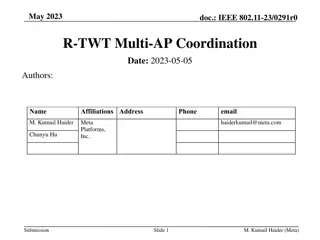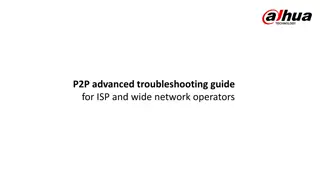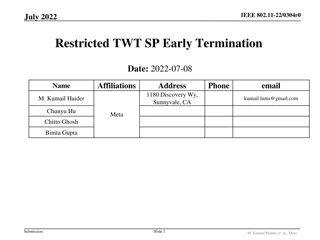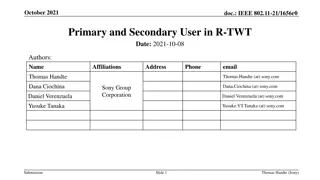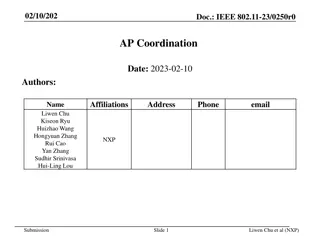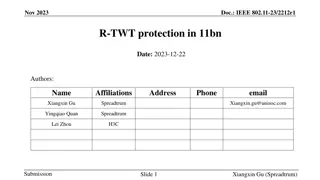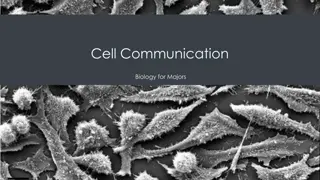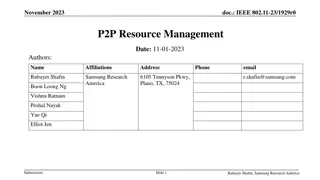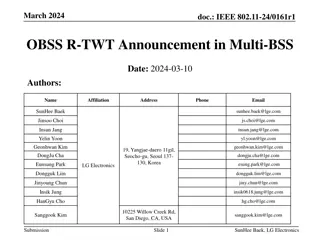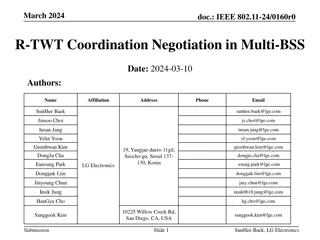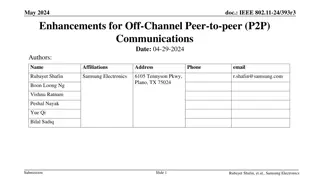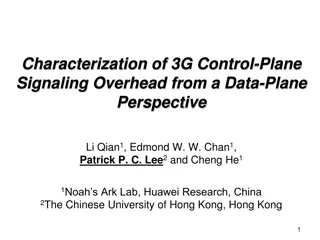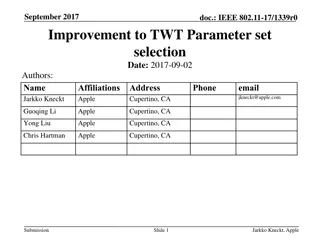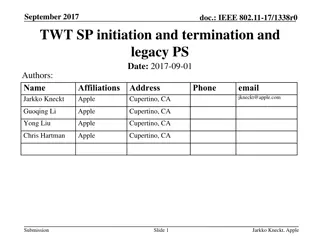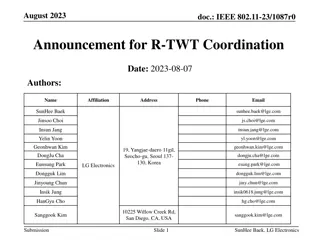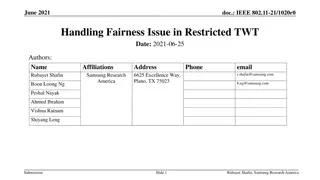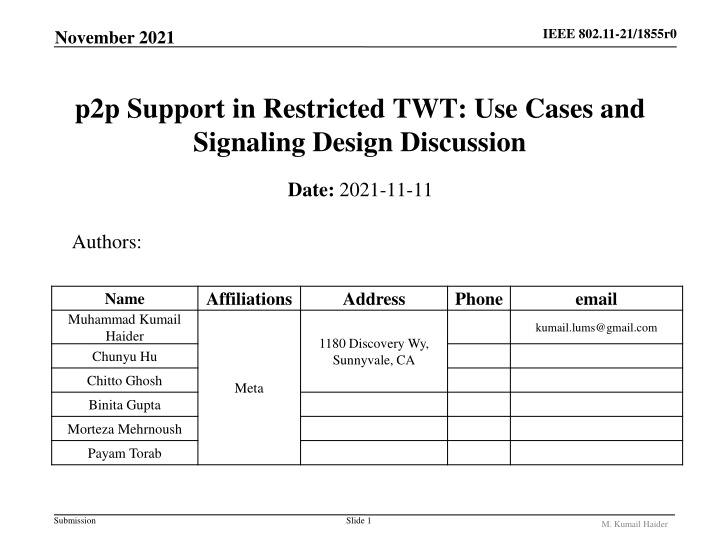
Restricted TWT Support in IEEE 802.11-21: Use Cases and Signaling Design Discussion
Discussing the use of restricted TWT support for peer-to-peer communication in IEEE 802.11-21, this content covers examples of p2p use cases, proposed signaling designs, and scenarios with new signaling methods to address key comments and clarifications. The document explores the implications of Recommendation Value 5 and the benefits of explicit signaling for p2p traffic support.
Download Presentation

Please find below an Image/Link to download the presentation.
The content on the website is provided AS IS for your information and personal use only. It may not be sold, licensed, or shared on other websites without obtaining consent from the author. If you encounter any issues during the download, it is possible that the publisher has removed the file from their server.
You are allowed to download the files provided on this website for personal or commercial use, subject to the condition that they are used lawfully. All files are the property of their respective owners.
The content on the website is provided AS IS for your information and personal use only. It may not be sold, licensed, or shared on other websites without obtaining consent from the author.
E N D
Presentation Transcript
IEEE 802.11-21/1855r0 November 2021 p2p Support in Restricted TWT: Use Cases and Signaling Design Discussion Date: 2021-11-11 Authors: Affiliations Address Phone email Name Muhammad Kumail Haider Chunyu Hu kumail.lums@gmail.com 1180 Discovery Wy, Sunnyvale, CA Chitto Ghosh Meta Binita Gupta Morteza Mehrnoush Payam Torab Submission Slide 1 M. Kumail Haider
IEEE 802.11-21/1855r0 November 2021 Abstract Discuss restricted TWT (r-TWT) use for peer-to-peer (p2p) communication o An example of p2p use-case o Proposed signaling design o Example scenario with the new signaling Submission Slide 2 M. Kumail Haider
IEEE 802.11-21/1855r0 November 2021 Background Several comments in D1.0 CC36 regarding p2p support in r-TWT feature (#4778, #6408) 21/1224 proposed adding a new Broadcast Recommendation value for p2p support in r-TWT. However, the resolution of p2p related CIDs was deferred pending further discussion. Key comments: o Clarify with examples of use-case and signaling o Clarify distinction between Recommendation Values 4 and 5 o MU RTS TXS Trigger scheduling provisions for p2p need further clarification; also specify both AP and STA support the feature This document follows up on the discussion to address aforementioned comments. Submission Slide 3 M. Kumail Haider
IEEE 802.11-21/1855r0 November 2021 Use Case Example AP Link1 Link2 STA 2 STA 1 tethered link STA2 connecting to cloud via STA1 on tethered link o Link 1: between AP and STA1 in an infrastructure BSS o Link 2: p2p link between STA 1 and STA 2. o Assumptions: Link 1 and Link 2 are on the same channel (in congested scenarios p2p link may have to be co-channel with BSS) Traffic over Link2 is not necessarily forwarded from Link1 (e.g. STA1 does rendering computation for STA2) STA 2 may not be associated with the AP or in range of the AP. STA 2 may be in range of other STAs in the BSS. o Objective: Provide support in r-TWT for STA1 s Latency Sensitive Traffic (LST) with STA 2. p2p traffic also benefits from r-TWT SP start boundary protection Some LST on p2p link may be to/from cloud (e.g., cloud gaming or various VR applications) and going through STA1. As such, using a single r-TWT SP for UL/DL + p2p traffic is a huge plus for STA1 s power saving and overall latency performance of application Submission Slide 4 M. Kumail Haider
IEEE 802.11-21/1855r0 November 2021 r-TWT support for p2p: Signaling Proposed to use new Broadcast TWT Recommendation value 5 in 21/1224 o Recommendation value 5 explicitly indicates both UL/DL and p2p exchanges are allowed in SP o Benefits of explicitly signaling in separate Recommendation Value In announcements, AP can specifically advertise schedule(s) during which it is willing to support p2p traffic During r-TWT setup, STA can explicitly convey its intention to use SP for its p2p traffic, and also optionally get resources from AP (see next slide) Submission Slide 5 M. Kumail Haider
IEEE 802.11-21/1855r0 November 2021 r-TWT support for p2p: Optional TXOP sharing Proposed text in 35.7.4.1: o If both the r-TWT scheduling AP and r-TWT scheduled STA have the Triggered TXOP Sharing Support subfield in EHT Capabilities element to 1, and if Trigger frame(s) are addressed to the r- TWT scheduled STA by the AP in a trigger-enabled restricted TWT service period negotiated with the STA with Broadcast TWT Recommendation field equal to 5, then at least one Trigger frame shall be an MU RTS TXS Trigger frame with TXOP Sharing Mode subfield equal to 2. The r-TWT scheduling AP is not expected to schedule for transmission MU RTS TXS Trigger frames with TXOP Sharing Mode subfield to 2 that are addressed to an r-TWT scheduled STA which establishes membership in one or more r-TWT schedule(s) with Recommendation value 5 outside of the corresponding TWT SPs. o Above statement doesn t preclude EDCA based access if the STA doesn t support TXOP sharing o Advantages for STA to get AP s assistance with TXOP sharing vs contending for its p2p traffic : STA is allocated time in TXOP for its p2p traffic each SP without contention Allocation of MU RTS TXS Trigger gives incentive to STA(s) to wait until trigger to deliver p2p traffic AP can manage p2p transmissions on the same channel by controlling when TXOPs are allocated, and reduce interference Submission Slide 6 M. Kumail Haider
IEEE 802.11-21/1855r0 November 2021 Example usage scenario of proposed signaling R-TWT SP (bTWT ID i) TWT IE indicates bTWT ID i with Recom. value 5 TXS Trig TWT Resp MU RTS Basic Trig TXOP sharing mode 2 Beacon BA AP STA1 Link 1 TB PPDU TWT Req CTS TXOP used for p2p traffic STA establishes mem in schedule with bTWT ID i with Recom. value 5 DATA BA STA1 STA2 Link 2 DATA BA AP advertises p2p support in r-TWT schedule with bTWT ID i by indicating Recommendation value 5 in corresponding restricted parameter set field of TWT IE in beacon STA1 sends a TWT request frame and includes a restricted TWT parameter set field with bTWT ID 5 and Recom value 5. It indicates TID t in UL as well, and indicates its resource requirements (SP duration, interval) via TWT parameters. It optionally includes TSPEC(s) to describe traffic s QoS characteristics AP sends TWT Response frame with ACCEPT TWT At r-TWT SP start, AP first solicits STA1 s UL traffic of TID t using Basic Trigger frame (could trigger multiple STAs) AP then sends an MU RTS TXS Trigger to STA1 with TXOP Sharing Mode 2 STA1 uses allocated TXOP to exchange LST on Link2 with STA2. o o o o o o Submission Slide 7 M. Kumail Haider
IEEE 802.11-21/1855r0 November 2021 Recommendation Value Setting Possibilities Below table gives further examples of possible Recommendation value settings in announcements and TWT negotiations o The possible values are indicated inside a restricted TWT parameter set in Broadcast TWT Recommendation subfield o For simplicity, we show the Recommendation Value in the initial TWT Request frame, and the final TWT Response frame with ACCEPT TWT; the negotiation may comprise multiple frame exchanges Scenario ID Announcement (Beacons) TWT Request TWT Response R-TWT SP Traffic Type Allowed for member STA 1 5 5 5 UL/DL + p2p 2 5 4 4 UL/DL 3 4 5 4 UL/DL 4 4 5 5 UL/DL + p2p Submission Slide 8 M. Kumail Haider
IEEE 802.11-21/1855r0 November 2021 Summary Discuss signaling design for p2p support in r-TWT and clarify/extend rules for using MU RTS TXS Trigger with TXOP Sharing Mode 2 for p2p traffic Example use case scenario and how the proposed signaling may be used p2p support in r-TWT can help latency sensitive traffic on p2p link benefit from start boundary protection and scheduling of r-TWT, and can help improve overall latency for several applications and use cases where p2p traffic is involved Submission Slide 9 M. Kumail Haider


